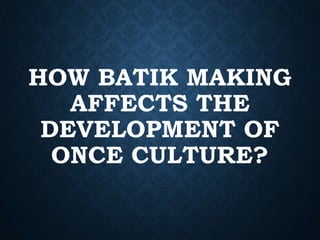Southeast Asian Arts, Fabric/Fabric design (Batik)
- 2. WHAT ARE THE TWO CATEGORIES OF BATIK DESIGN? ŌĆóGeometric Motifs ŌĆóFree Form Designs
- 3. WHAT IS THE DIFFERENCE BETWEEN HAND-PAINTED BATIK TO BLOCK PRINTED BATIK? ’ā╝Hand painted - the artist uses the canting, a small copper container with one or more different-sized pipes ’ā╝Block printed - done by welding together strips of metal to form a metal block. The metal block is then dipped into molten wax and pressed against the fabric in order to make a pattern
- 4. HAND PAINTED
- 7. MALAYSIAN BATIK ŌĆó Leaves and flowers in Malaysian batiks are incorporated to avoid the interpretation of human and animal images as idolatry, in accordance with local Islamic doctrine. ŌĆó famous for its geometrical designs or spirals ŌĆó More brush painting is applied to be able
- 8. INDONESIAN BATIK ŌĆópatterns are larger and simpler ŌĆódeep colored
- 9. SINGAPOREAN BATIK ŌĆórecorded since the 12th century but has receded its popularity through the years. ŌĆófeatured in as the uniform of flight attendants
- 10. BRUNEI TRADITIONAL TEXTILE ŌĆóalso called batik but it is uniquely different from Indonesia, Malaysia and Singapore. ŌĆódesigns have their national flower simpur, sumboi-sumboi (pitcher plant) and Brunei's traditional design of air muleh.
- 11. BATIK CAN BE DONE BY FOUR DIFFERENT WAYS: 1.hand-drawn 2.using metal blocks 3.screen printing 4.digital printing
- 12. Identify the pictures whether it is: ’ā╝Malaysian Batik ’ā╝Indonesian Batik ’ā╝Singaporean Batik ’ā╝BruneiŌĆÖs Batik
- 14. MALAYSIAN BATIK
- 15. INDONESIAN BATIK
- 16. BRUNEIŌĆÖS BATIK
- 17. MALAYSIAN BATIK
- 18. INDONESIAN BATIK
- 19. BRUNEIŌĆÖS BATIK
- 20. MALAYSIAN BATIK
- 21. HOW BATIK MAKING AFFECTS THE DEVELOPMENT OF ONCE CULTURE?
- 22. WHAT CAN YOU SAY ABOUT THE SOUTHEAST ASIAN FABRIC DESIGN?
- 23. HOW INDIGENOUS PEOPLE ESTABLISHED SMALL BUSINESS ENTERPRISES AND PRODUCED TRADITIONAL PRODUCTS TO GENERATE SUPPLEMENTARY INCOME TO SUPPORT THEIR LIVELIHOOD?
- 24. ACTIVITY: ŌĆ£BATIK MAKINGŌĆØ ŌĆó Rubric: pp. 198
- 25. RESEARCH ON THE FOLLOWING: 1.Loy kratong 2. Wayang kulit 3. Wau kite 4. songkok

























